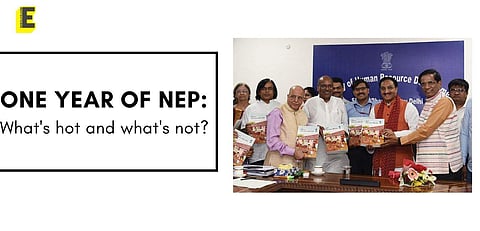

From "making India the knowledge capital of the world" (Piyush Goyal) to a "weapon that can damage the education system" (Rahul Gandhi), the National Education Policy(NEP) has been given monikers aplenty since it was launched one year ago. PM Narendra Modi is set to unveil ten new education schemes to “celebrate” the NEP. But what exactly are we celebrating a year later? Only India's third proper education policy since independence, the NEP was cleared on July 29, 2020 by the union cabinet, and it proposed some major changes to the education system in the country.
Here are 4 of the most striking proposals, and what has become of them over the last year.
Four-year arts and science degrees with multiple exits: The NEP had proposed that instead of the current three-year undergraduate system for arts and science degrees, the structure be broken down into four years, where the students will get certified based on the period of the course they take. Accordingly, they will receive a certificate if they do a one-year study, a diploma if they pursue it for two years, a degree if they stick it out for three years, and if they complete four years in the course, they stand to get a degree with research. This method was supposed to give students the leeway to shift fields if they so wished, and possibly garner skill-based education. Further, the multiple exit options allow the students to pause a course midway, work, or pursue another course and then come back to it in the same or different institution. The system proposed was done with the aim to take away the threat of the students losing a year if they decide to shift streams or take a gap to work.
What has happened: Higher Education Secretary Amit Khare had linked this proposal as one of the “non-financial reforms” which require a “new way of thinking” rather than money to implement. The multiple entries and exit options were made available to universities from the academic year 2020-21, and the four-year degree programme was set to be introduced in central universities this year.
Single regulator for higher education: In a move to streamline administration of higher education, the NEP had proposed a Higher Education Commission of India(HECI) which would take the place of both the University Grants Commission (UGC) and the All India Council for Technical Education (AICTE). The HECI is supposed to have four “verticals” for functions in regulation, accreditation, grants, and general education. Technically, the UGC performs these actions, along with “inspection” of institutions. However, in August last year, Amit Khare had said that the HECI will be based on “self-disclosure” and not inspection in a bid to cut red tape, and let educational institutions focus on “the standard of education.”
What has happened: The Minister had also said that the bill was being drafted and would be available by the end of September 2020. Cut to July 2021, and the newly-appointed Education Minister Dharmendra Pradhan recently said that the bill was still being drafted.
Academic Bank of Credit: In the lateral study system, where students are allowed to skip from one college to the next, and from one course to another, the NEP had also suggested a “bank” for the credits earned in each course, which would be stored and incorporated into the final degree the student takes.
What has happened: The PM is launching a scheme to set up the Academic Bank of Credit on the anniversary of the NEP. Last year, ThePrint had reported a senior official in the education ministry suggesting that a test run might be conducted for the credit bank in December, which did not pan out.
Three language policy with importance given to Sanskrit: The NEP had proposed it being mandatory for students until Class V be taught in their regional languages. The policy had also asked schools to provide options to study in three languages, out of which two would be indigenous, which means that English might take a backseat. Further, it had suggested setting up a body for translations with stress on Sanskrit and other languages, called Indian Institute of Translation and Interpretation. Sanskrit was also to be preferably included as one among the three languages offered in school, and the setting up of Sanskrit universities was also suggested.
What has happened: The Education Minister had said that this year, technical education such as engineering courses would be offered in eight regional languages, and PM Modi is expected to launch a scheme along the same lines on the anniversary of the NEP. Already, 14 colleges in the country have announced engineering courses in regional languages. A majority of these are from Uttar Pradesh. States, especially Tamil Nadu, have earlier protested against the alleged importance being given to Hindi and Sanskrit, stating that it would undermine local languages. There were also protests when the Telugu Akademi had recently changed its name to Telugu and Sanskrit Akademi
